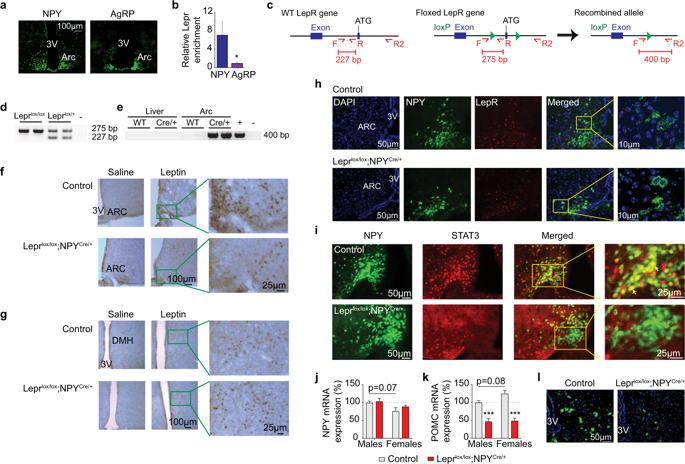International Journal of Obesity ( IF 4.2 ) Pub Date : 2020-03-09 , DOI: 10.1038/s41366-020-0550-6 Nicola J Lee 1, 2 , Yue Qi 1 , Ronaldo F Enriquez 1 , Ireni Clarke 1 , Chi Kin Ip 1, 2 , Natalie Wee 3 , Paul A Baldock 2, 3 , Herbert Herzog 1, 2

|
Background/objectives
Maintaining energy balance is important to ensure a healthy organism. However, energy partitioning, coordinating the distribution of sufficient energy to different organs and tissues is equally important, but the control of this process is largely unknown. In obesity, an increase in fat mass necessitates the production of additional bone mass to cope with the increase in bodyweight and processes need to be in place to communicate this new weight bearing demand. Here, we investigate the interaction between leptin and NPY, two factors critically involved in the regulation of both energy metabolism and bone mass, in this process.
Methods
We assessed the co-localization of leptin receptors on NPY neurons using RNAScope followed by a systematic examination of body composition and energy metabolism profiling in male and female mice lacking leptin receptors specifically in NPY neurons (Leprlox/lox;NPYCre/+). The effect of short-term switching between chow and high-fat diet was also examined in these mice.
Results
We uncovered that leptin receptor expression is greater on a subpopulation of NPY neurons in the arcuate that do not express AgRP. We further show that Leprlox/lox;NPYCre/+ mice exhibit significantly increased adiposity while bone mass is diminished. These body composition changes occur in the absence of alterations in food intake or energy expenditure, demonstrating a prominent role for leptin signaling in NPY neurons in the control of energy partitioning. Importantly however, when fed a high-fat diet, these mice display a switch in energy partitioning whereby they exhibit a significantly enhanced ability to increase their bone mass to match the increased bodyweight caused by higher caloric intake concurrent with attenuated adiposity.
Conclusions
Taken together, these results demonstrate that leptin signaling in NPY neurons is critical for coordinating energy partitioning between fat and bone mass especially during situations of changes in energy balance.
中文翻译:

脂肪和骨量之间的能量分配是通过下丘脑瘦素/NPY 继电器控制的。
背景/目标
保持能量平衡对于确保健康的机体很重要。然而,能量分配,协调足够的能量分配到不同器官和组织同样重要,但这个过程的控制在很大程度上是未知的。在肥胖症中,脂肪量的增加需要产生额外的骨量来应对体重的增加,并且需要适当的过程来传达这种新的负重需求。在这里,我们研究了瘦素和 NPY 之间的相互作用,这两个因素在这个过程中与能量代谢和骨量的调节密切相关。
方法
我们使用 RNAScope 评估了瘦素受体在 NPY 神经元上的共定位,然后系统检查了缺乏瘦素受体的雄性和雌性小鼠的身体成分和能量代谢谱,特别是在 NPY 神经元中(Lepr lox/lox;NPY Cre/+)。还在这些小鼠中检查了食物和高脂肪饮食之间短期转换的影响。
结果
我们发现,在弓状体中不表达 AgRP 的 NPY 神经元亚群中,瘦素受体表达更高。我们进一步表明 Lepr lox/lox ;NPY Cre/+小鼠的肥胖显着增加,而骨量减少。这些身体成分的变化发生在食物摄入或能量消耗没有改变的情况下,表明瘦素信号在 NPY 神经元中在控制能量分配方面发挥着重要作用。然而,重要的是,当喂食高脂肪饮食时,这些小鼠表现出能量分配的转变,从而它们表现出显着增强的增加骨量的能力,以匹配由较高热量摄入引起的体重增加,同时减轻肥胖。
结论
总之,这些结果表明 NPY 神经元中的瘦素信号对于协调脂肪和骨量之间的能量分配至关重要,尤其是在能量平衡发生变化的情况下。











































 京公网安备 11010802027423号
京公网安备 11010802027423号